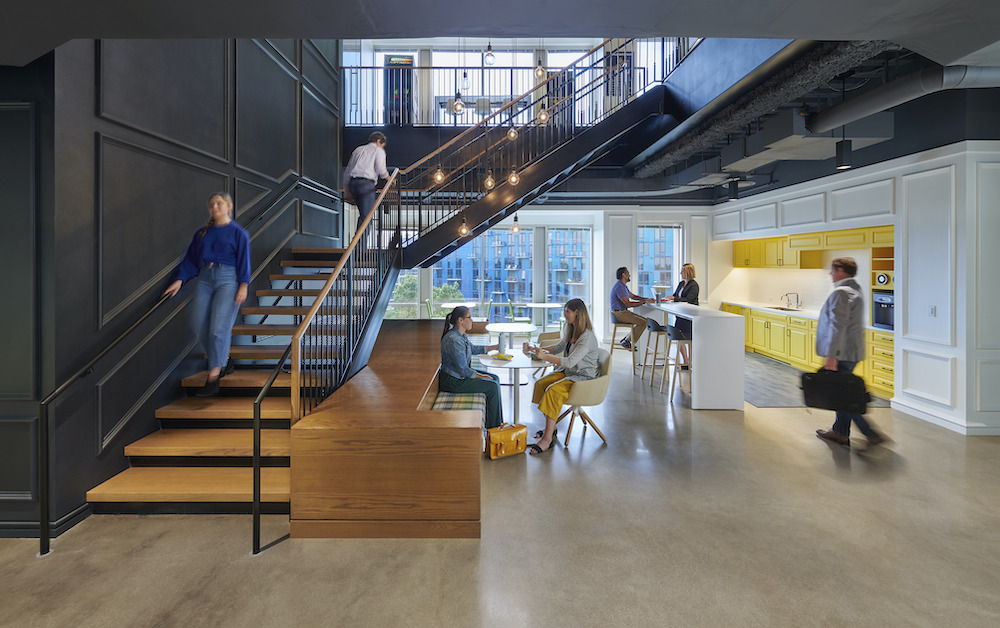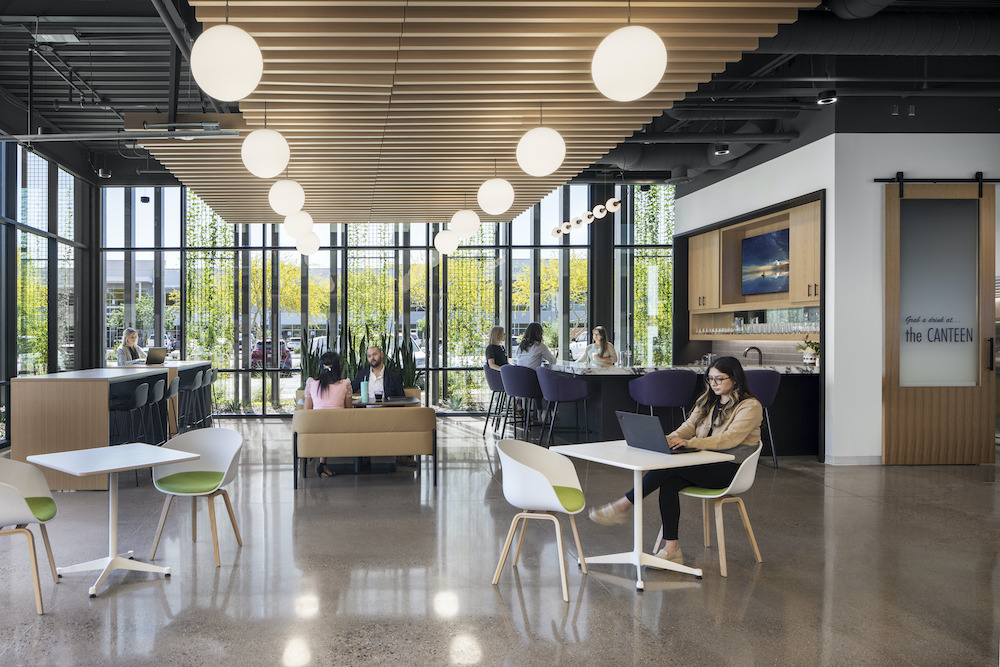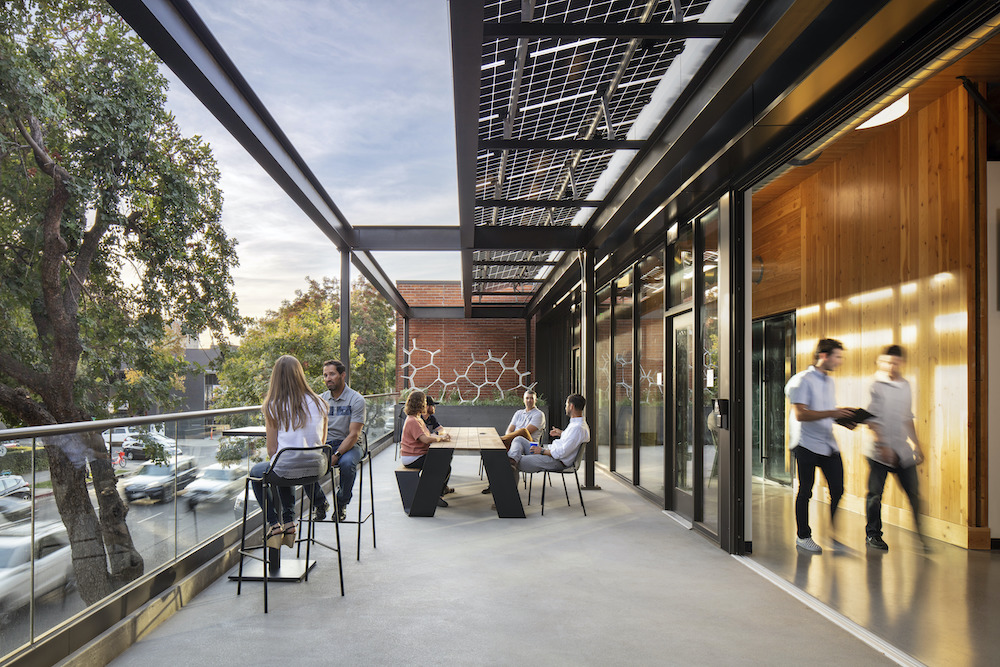- For Gen Z, flexibility, autonomy, work/life balance and physical and mental wellbeing have become “must have” priorities across the board.
- Companies that authentically demonstrate and reinforce the value and contributions that Gen Z employees bring to the organization will win their loyalty.
- Workplace designers have the power to break the status quo and change the workplace for decades to come.
This article was written by Megan Skaalen and Emily Morris of SmithGroup for Work Design Magazine.
Four to five short years ago, the first wave of Generation Z knew what their futures would hold. They were poised to say goodbye to college life and enter the workforce as salaried professionals. And it was expected — and accepted — that they would spend five days a week in an office working, learning and growing alongside established and experienced colleagues. Then, in March of 2020, “traditional” professional life was forever changed.
Today, we are still exploring how a new era of workplace strategies, modalities, norms and office design solutions can support the varying expectations, wants and needs of a multigenerational workforce — with added emphasis on the growing Gen Z population. Flexibility, autonomy, work/life balance and physical and mental wellbeing have become “must have” priorities across the board, but generations remain staunchly split on the need to be in the office and the value that comes from in-person interaction with colleagues.
As a result, Gen Z employees find themselves navigating the technical and the softer aspects of professional development on their own, without the benefits that frequent face-to-face engagement, mentorship and personal connections afforded past generations.

Adding a Gen Z voice to the conversation.
Up to this point, many discussions on how to proceed from here have primarily been from the vantage point of more senior and experienced members of the workforce. Yet, this segment of employees continues to wholeheartedly embrace remote work — with many expressing little desire to return to the office with regular frequency.
So, we invited an enthusiastic, circa-2019-graduate interior designer and Gen Z colleague to join the conversation. We asked her to share what time spent working remotely during COVID was like, and how that experience impacted her perspective on the role that office environments should play in career growth, development, and professional connectivity.
A Gen Z-er reflects on the pros and cons of working entirely from home:
“My first year in the field, I was working full-time in the office. I had a strong sense of routine. I would arrive at 8:00 AM sharp, like my life depended on it. I knew exactly what to expect out of my work week and I knew my colleagues and mentors would be there to help me through the day. Most importantly, I knew what was expected of me as a professional by watching those around me.
Peripheral learning was invaluable. Overhearing colleagues navigate scenarios and challenge ideas proved essential to understanding how teammates across disciplines and offices worked in partnership to achieve a client’s goals. Observing first-hand how good ideas could flourish into spectacular ideas and how teams arrived at the most well-rounded solution was both educational and invigorating.
When the “work from home” era began it was shocking at first, but certainly there were benefits to working from home — like no commute, healthier meals, and having autonomy over when and how assignments were tackled.
As the remote journey stretched on, new collaboration tools were created and virtual meetings became more efficient, but it felt like there was never a clear stopping point to the workday. Each day blurred into the next. Burnout was a definite possibility and loneliness began to set in.

Eventually, the experience gave rise to new observations. For instance, I came to realize that previously being able to work alongside colleagues in-person helped me undertake and work through deadlines in a much healthier, more sustainable way. And being able to pack up and return to our personal lives after a long day had a profound effect on overall wellbeing. Would these experiences ever again become the norm?
Yes! The work from home mandate was lifted and employees can now choose whether to go into the office or work remotely. And while the desire to return to the office varies from person to person, having this flexibility and choice has become incredibly important to so many of us.
It seems impossible to maintain completely remote operations long-term. If hybrid work becomes the new normal, it will be important to encourage staff to establish a set schedule of in-office vs. remote workdays. Certainly, this helps with coordinating tasks and deadlines, but it goes a long way towards managing personal expectations, too. It can be incredibly deflating to come to the office and find yourself working in a ghost town when you were looking forward to some quality human interaction.”
So, how do we keep Gen Z engaged and wanting to come back?
Inspiration & Interaction
Gen Z wants to be inspired and ascribe meaning to all facets of life. Strong corporate values and objectives can create a vibrant ecosystem buzzing with curiosity and inspiration. At the same time, there’s nothing more triggering to Gen Z than the “fear of missing out,” or FOMO. Create an office with a bustling hub of activity and sense of community — they will be there, and they’ll keep coming back.
Keep it Agile
Like many organizations, SmithGroup has seen much success with flexible, agile workspace environments that allow employees to choose from a range of seating options and flex as projects evolve. Younger generations expect transparency and like how open offices dissolve siloes and flatten hierarchies. Generation Z is still trying to figure out what their career paths and futures might look like. Having the opportunity to sit beside a principal, observe leaders and teams in action, and learn what it takes to grow and achieve new levels of expertise is energizing and appreciated by Gen Z.
Perks Are a Plus…
Team breakfasts and occasional refreshment hours, fitness facilities, access to the outdoors, free parking, offices in downtown locations, flex areas, and spaces that support balance and connectivity all appeal to Gen Z. More importantly, they reinforce that employees are valued human beings and not just a number in the system. Companies that authentically demonstrate and reinforce the value and contributions that Gen Z employees bring to the organization will win their loyalty. In return, Gen Z will show up day after day and produce the best quality work they can.
…But Connection Remains Key
No matter where Gen Zers choose to work, they want to contribute and add meaning to their lives. They want to feel like they are part of something much bigger than themselves. But from their perspective, they can accomplish almost anything work related at home. So, what’s missing?
It all boils down to connection. It’s nearly impossible to feel authentic human connection and form genuine bonds through virtual interaction alone. So, it comes as no surprise that this generation craves camaraderie, trust, mentorship and healthy relationships above all else. Work deadlines can get intense. Gen Z wants to know that they can trust and rely on teammates — and learn from experienced leaders — when the pressure is on, and a project needs to get across the finish line. And, finally, when those deadlines have passed, this group wants to create authentic connections outside of work.
“Some of the best advice I’ve received from mentors was off the clock during social activities,” shared our Gen Z author.

The Future is Now
One can’t help but be excited to witness the change and evolution taking place within Gen Z and the world of work. As designers, we have the power to break the status quo and change the workplace for decades to come. This means we also have a responsibility to create healthy, safe, inspiring physical office spaces that support an individual’s overall wellbeing while also enabling employees to connect, collaborate, dream, thrive, and succeed. Technology may make it easy to adopt entirely remote work modalities, but nothing can — or should — replace the value that comes from authentic human connection.


 Dr. Gleb Tsipursky – The Office Whisperer
Dr. Gleb Tsipursky – The Office Whisperer Nirit Cohen – WorkFutures
Nirit Cohen – WorkFutures Angela Howard – Culture Expert
Angela Howard – Culture Expert Drew Jones – Design & Innovation
Drew Jones – Design & Innovation Jonathan Price – CRE & Flex Expert
Jonathan Price – CRE & Flex Expert















